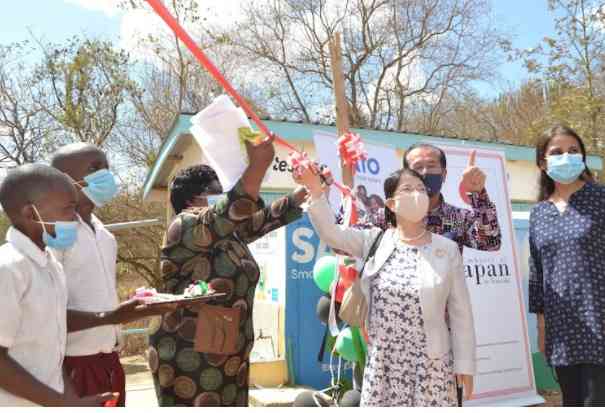The Struggle With Mense among Primary School Girls

- Kavingo is among schools in Kitui that have benefited from S-UHC SATO toilets project
- S-UHC School WASH project is funded by Japan and implemented along with Unicef
A school girl in Kitui aptly captures the burden of stress that the Sanitation for Universal Health Coverage school project has lifted from the shoulders of girls during menses.
“Previously, girls entering puberty used to go home and change but they now can go to the bathrooms and change without much ado; go back to class to continue with lessons,” said Gift Kalimi, who is in standard seven at Kavingo Primary School.
She was addressing guests who included the Japanese Ambassador to Kenya, Horie Ryoichi, his wife Horie Yuko, and Unicef representative, Kenya Maniza Zaman during the handover of the S-UHC facility at Kavingo primary school in Nzambani district of Kitui County.
As she thanked the benefactors who funded and installed the WASH (water, sanitation and hygiene) facilities at her school, the pupil said henceforth girls at her school will never again have to miss lessons due to issues related to menstruation.
Young Kalimi’s sentiments epitomised the relief and benefits school girls transiting to puberty in 97 primary schools across Kitui County are set to reap from the modern lavatories, dubbed Sato toilets.
- The S-UHC school Wash project in a number of counties in Kenya was funded to the tune of $10 million by the Japanese government and implemented in cooperation with Unicef.
- Together with the Sato toilets, the facilities also encompass disability-friendly structures.
“Each of the 97 schools have two sanitation facilities that are gender and disability-friendly. All the facilities have running water for handwashing,” the Kitui County education department School WASH Focal Person, Justina Peireira, disclosed.
She said the S-UHC school Wash project facilities are distributed across four sub-counties in Kitui with Mwingi central sub county having 39 schools benefiting while 25 schools in Mwingi North are beneficiaries. The other beneficiary counties are Kitui South (19 schools) and Kitui East (14 schools).
She added: “While the boys’ facilities have nicely done urinals, the girls’ facilities have bathrooms specifically meant for the menstrual hygiene management (MHM).” She further said in the exclusive toilets for the disable learners, latrine pits are fitted with SATO stools for comfort.
Pereira disclosed the S-UHC school Wash project serves a total of 42,296 school children in Kitui out of which 21,104 are girls while 21,192 are boys. She said besides ensuring improved hygiene, the project would catalyse both high learner retention and transition.
Kavingo Primary School head-teacher, Dedan Kinywa, said of the sanitation Sato facilities: “They have been put up using cutting edge technology and they are rightly CBC compliant. Learners will really enjoy using them.”
He added that the initiative would translate to high learners’ retention in schools, improvement in teacher-learner interaction resulting to quality and impactful learning among pupils and general improved performance.
Ryoichi, in his address during the project handover ceremony, said the low-cost and high hygiene Sato toilets have a special function of keeping high sanitary levels and are easy to clean.
“In the Sanitation for Universal Health Coverage project, we have provided five counties in Kenya with about 10,000 toilets. Kitui County is one of the largest beneficiaries of the project,” noted the envoy.
He said in providing the toilets, the idea was to eliminate open defecation, which has adverse effects on the health and development of children whose immune systems are yet to fully develop.
The envoy expressed optimism that the learners at Kavingo primary school would enjoy using the clean and sanitary toilets as well as keep them clean so that next users would also enjoy the same alluring experience.
- Over 85 per cent of open defecation in Kenya takes place in 15 counties (high burden Counties) and six counties have rates exceeding 40 per cent
- According to Unicef, Kenya is one of the 26 countries in the world contributing to 90 per cent of open defecation in the world.
- Although progress has been made in Kenya to eliminate open defecation, we are still moving at a very slow pace to achieve targets set in Kenya’s Vision 2030 and SDG 6.